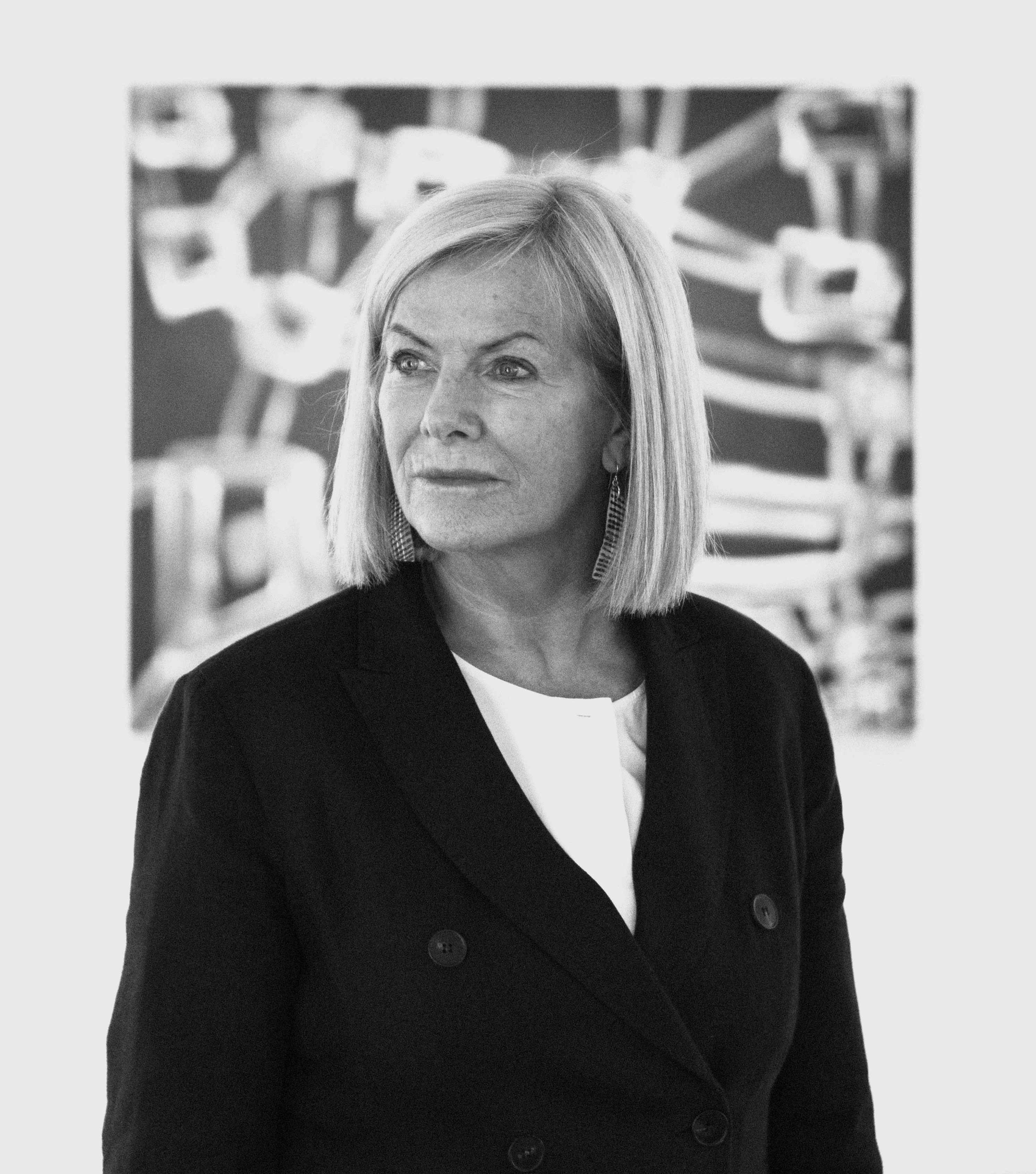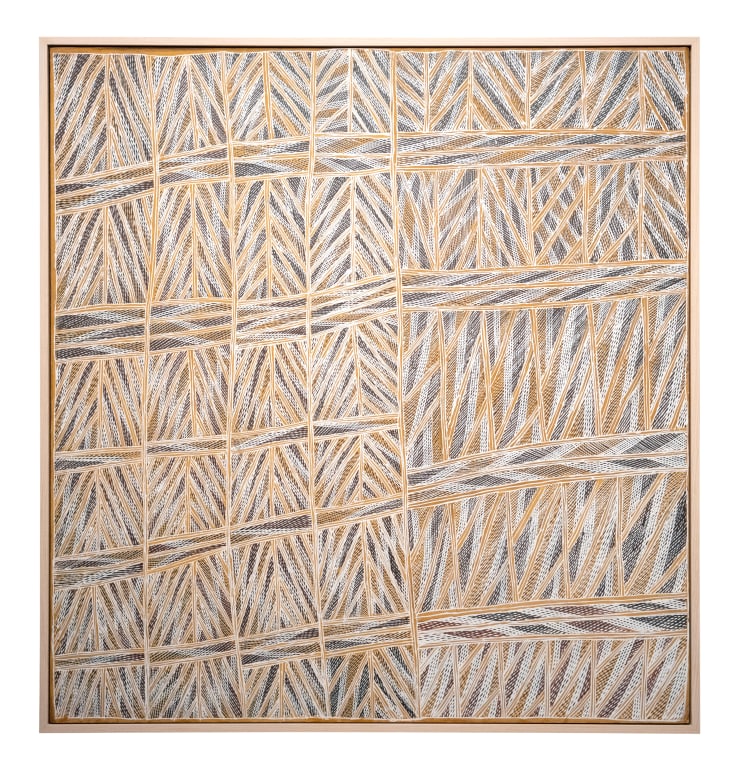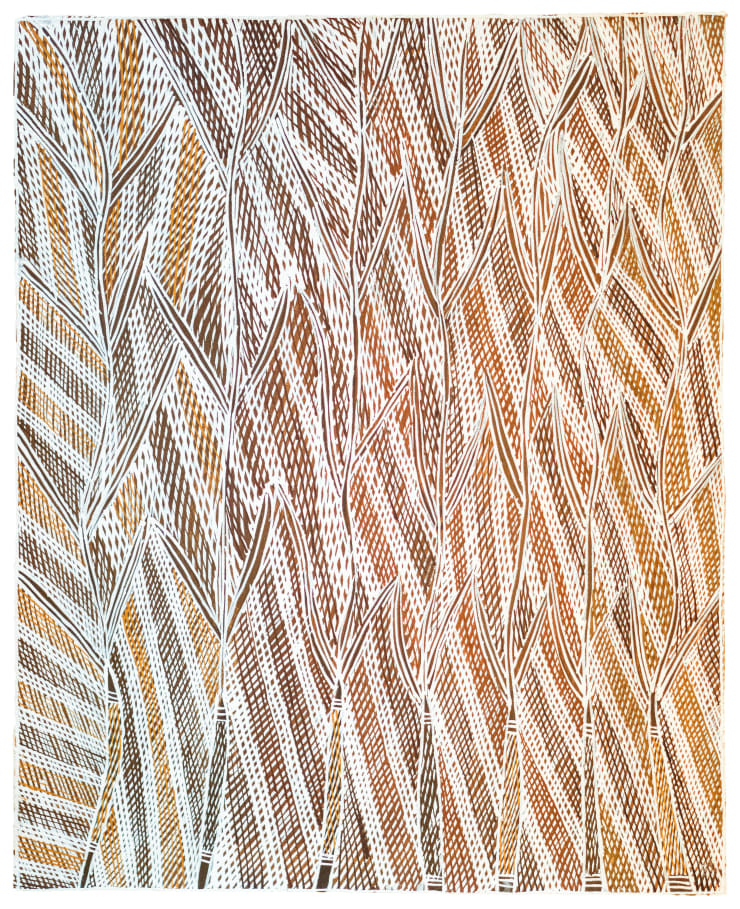Gurrutu: The Art Of Mulkun Wirrpanda: An exhibition of works on Larrakitj, bark, board & paper by the late Mulkun Wirrpanda
“Numbers constitute a system of meaning which we project onto the world to understand it. You will never see a tree by the side of the road sprouting a bunch of number sevens. And if we had been born with 11 fingers, our number system would be completely different. The Yolnu have an equally complex system which fulfils the same purpose: gurrutu, which connects every single element of the cosmos within a matrix of meaning, but which is invisible to us and too complex for casual comprehension. But gurrutu and numbers are as real - or as unreal - as each other. If you want to communicate with Yolnu, you need to have the architecture of gurrutu in your mind.”
- Will Stubbs (Coordinator at the Buku-Larrnggay Mulka Art Centre).
"The seeds of this exhibition were sown in August of 2022 when I visited Will Stubbs and Dave Wickens at the Buku-Larrnggay Mulka Art Centre in Yirrkala (northeastern Arnhem Land). Situated on a coastline overlooking the Arafura Sea, Buku-Larrnggay Mulka is the quintessential Art Centre and one of my favourite cultural institutions. I have known Will for almost two decades and have, over this period, seen the Centre thrive through his guidance.
Will’s artistic insights are always invigorating and revelatory. Our conversation during this visit was no different. He showed me the work of the recently deceased Mulkun Wirrpanda, a Yolnu woman whose reputation precedes her, but whose Art I had not, until that moment, seen in close detail.
The aesthetic was distinct from any painting or drawing I’d previously seen. This was perhaps a result of Wirrpanda’s novel conceptual approach. Rather than depicting her Dreaming or Country, she had instead focused, with a botanist’s precision, on the plants and foodstuffs that had sustained her and her ancestors for millenia. The works were, aesthetically, incredibly striking, but there also seemed to be a utilitarian undertone to them. They seemed to constitute a manual of sorts, intended to inform future generations on the ecological wisdom of the artist’s ancestry.
Wirrpanda was an active senior Yolnu elder and participated in almost every aspect of community life. This included, as Will informed me, ceremonies which sometimes ran for weeks or months at a time. She was ideally placed, therefore, as a repository of Yolnu knowledge. Gurrutu: The Art Of Mulkun Wirrpanda stands as a testament to the life of a woman with formidable artistic talent and a symbiotic sensibility. It is an honour to be entrusted with the exhibition by both the Buku-Larrnggay Mulka Art Centre and the artist’s estate."
- Foreword to exhibition by Jennifer Guerrini Maraldi (Director of JGM Gallery)

Jennifer Guerrini Maraldi, 2022. Image courtesy of Julius Killerby
Amongst the works in Gurrutu: The Art Of Mulkun Wirrpanda are various depictions of termite ecosystems. Many of these were the result of a collaboration in 2019 with the artist, John Wolseley. In these works Wirrpanda depicts the mounds of ‘munyukulunu’, magnetic or compass termites (Amitermes Meridionalis), a species of eusocial insect that is endemic to northern Australia. These mounds are populated by the termites’ symbiotic partners: ‘nadi’, or northern meat ants (Iridomyrmex Sanguineus), diverse bird species and their eggs, as well as beehives. Harmonious ecologies such as these exemplify, through a micro example, Wirrpanda’s broader societal and world views.
Gurrutu: The Art Of Mulkun Wirrpanda is the result of an ongoing relationship between JGM Gallery’s Jennifer Guerrini Maraldi and the Buku-Larrnggay Mulka Art Centre. Guerrini Maraldi says of the association that “We (JGM Gallery) have had a longstanding relationship with the Buku-Larrnggay Mulka Art Centre. It is an honour to be entrusted with this exhibition by both the Art Centre and the artist’s estate.”
-
 Mulkun Wirrpanda, Birrkuda, 2008
Mulkun Wirrpanda, Birrkuda, 2008 -
 Mulkun WirrpandaUntitled II (Final Work), 2021A series of 15 works on paper135cm x 112cm
Mulkun WirrpandaUntitled II (Final Work), 2021A series of 15 works on paper135cm x 112cm -
 Mulkun Wirrpanda, Dhuwa
Mulkun Wirrpanda, Dhuwa -
 Mulkun Wirrpanda, Gan'kurr, 2019
Mulkun Wirrpanda, Gan'kurr, 2019 -
 Mulkun Wirrpanda, Nirriwan, 2019
Mulkun Wirrpanda, Nirriwan, 2019 -
 Mulkun Wirrpanda, Untitled XI, 2020
Mulkun Wirrpanda, Untitled XI, 2020 -
 Mulkun Wirrpanda, Nambarra I, 2017
Mulkun Wirrpanda, Nambarra I, 2017 -
 Mulkun Wirrpanda, Nambarra II, 2017
Mulkun Wirrpanda, Nambarra II, 2017 -
 Mulkun Wirrpanda, Nanka-Bakarra, 2017
Mulkun Wirrpanda, Nanka-Bakarra, 2017












